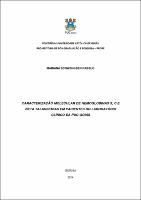| Compartilhamento |


|
Use este identificador para citar ou linkar para este item:
http://tede2.pucgoias.edu.br:8080/handle/tede/2399Registro completo de metadados
| Campo DC | Valor | Idioma |
|---|---|---|
| dc.creator | Rabelo, Mariana Schwengber | - |
| dc.creator.Lattes | http://lattes.cnpq.br/3019805790261278 | por |
| dc.contributor.advisor1 | Moura, Katia Karina Verolli de Oliveira | - |
| dc.contributor.advisor1Lattes | http://lattes.cnpq.br/0087299570422353 | por |
| dc.contributor.referee1 | Reis, Paulo Roberto de Melo | - |
| dc.contributor.referee1Lattes | http://lattes.cnpq.br/7729613632937834 | por |
| dc.contributor.referee2 | Santos, Fernando Antonio Vinhal dos | - |
| dc.contributor.referee2Lattes | http://lattes.cnpq.br/6312560674800466 | por |
| dc.date.accessioned | 2016-08-10T10:39:07Z | - |
| dc.date.available | 2016-01-13 | - |
| dc.date.issued | 2014-10-09 | - |
| dc.identifier.citation | RABELO, Mariana Schwengber. CARACTERIZAÇÃO MOLECULAR DE HEMOGLOBINAS S, C E BETA TALASSEMIAS EM PACIENTES DO LABORATÓRIO CLÍNICO DA PUC-GOIÁS.. 2014. 50 f. Dissertação (Mestrado em Ciências Humanas) - Pontifícia Universidade Católica de Goiás, GOIÂNIA, 2014. | por |
| dc.identifier.uri | http://localhost:8080/tede/handle/tede/2399 | - |
| dc.description.resumo | As hemoglobinopatias formam um grupo de alterações hereditárias prevalentes em várias regiões do mundo, mas atingem significativamente a população brasileira por sua miscigenação abundante. São alterações em genes estruturais, que ocasionam a formação de hemoglobinas variantes, e-ou em genes reguladores, causando as talassemias. Atualmente, o número de hemoglobinas anormais identificadas tem aumentado devido à melhoria nas metodologias de análises, no entanto, muitos laboratórios de rotina não estão preparados para a correta identificação destas alterações. No presente estudo objetivamos avaliar a prevalência das hemoglobinopatias por meio de métodos clássicos e fazer a caracterização molecular das mutações S, C, beta talassemia IVS-110, IVS-1, IVS-6 e CD-39 pela amplificação gênica utilizando a técnica do PCR-AE. O estudo molecular utilizou primers específicos que se ligam pontualmente na posição do alelo mutado e na respectiva posição do alelo normal, podendo assim realizar amplificação gênica alelo específica. Foram coletadas 200 amostras de sangue periférico de pacientes do Laboratório Clínico da PUC-Goiás no período de julho-2012 a dezembro-2012. Os resultados evidenciaram a validade da metodologia molecular na caracterização das mutações, sendo observados dois pacientes (1%) AC, um (0,5%) AS, dois (1%) com mutação IVS-6 e um (0,5%) IVS-6. O códon 39 e IVS-110 não foram detectados em nenhum dos pacientes investigados. | por |
| dc.description.abstract | The hemoglobinopathies are a group of heritable changes prevalent in various regions of the world, but significantly affect the Brazilian population for its abundant miscegenation. Are changes in structural genes that cause the formation of hemoglobin variants, and - or regulatory genes, causing thalassemias. Currently, the number of identified abnormal hemoglobin has increased due to improvements in methods of analysis, however, many routine laboratories are not prepared for the correct identification of these changes. In the present study aimed to assess the prevalence of hemoglobinopathies using classical methods and make the molecular characterization of mutations S, C, beta thalassemia IVS-110, IVS-1, IVS-6 and CD-39 by gene amplification using the PCR technique (Polymerase Chain Reaction). The molecular study used specific primers that bind promptly at the position of the mutated allele in position and the normal allele can thereby carry out gene allele specific amplification. 200 peripheral blood samples of patients of the Clinical Laboratory at PUC-Goiás were collected during July - December 2012-2012. The results showed the validity of the methodology in the molecular characterization of mutations, two (1%) AC patients, an one (0,5%) AS, two (1%) with mutation IVS-6 and one (0,5%) IVS-1 observed. The codon 39 and IVS-110 were not detected in any of the patients investigated. | eng |
| dc.description.provenance | Made available in DSpace on 2016-08-10T10:39:07Z (GMT). No. of bitstreams: 1 MARIANA SCHWENGBER RABELO.pdf: 832715 bytes, checksum: 2706eef7f6a3e8662625069e50c1529d (MD5) Previous issue date: 2014-10-09 | eng |
| dc.format | application/pdf | por |
| dc.thumbnail.url | http://localhost:8080/tede/retrieve/7808/MARIANA%20SCHWENGBER%20RABELO.pdf.jpg | * |
| dc.language | por | por |
| dc.publisher | Pontifícia Universidade Católica de Goiás | por |
| dc.publisher.department | Ciências Humanas | por |
| dc.publisher.country | BR | por |
| dc.publisher.initials | PUC Goiás | por |
| dc.publisher.program | Genética | por |
| dc.rights | Acesso Aberto | por |
| dc.subject | Hemoglobinopatias | por |
| dc.subject | Talassemias | por |
| dc.subject | PCR | por |
| dc.subject | Hemoglobinopathies | eng |
| dc.subject | Thalassemias | eng |
| dc.subject | PCR | eng |
| dc.subject.cnpq | CNPQ::CIENCIAS BIOLOGICAS::GENETICA | por |
| dc.title | CARACTERIZAÇÃO MOLECULAR DE HEMOGLOBINAS S, C E BETA TALASSEMIAS EM PACIENTES DO LABORATÓRIO CLÍNICO DA PUC-GOIÁS. | por |
| dc.type | Dissertação | por |
| Aparece nas coleções: | Mestrado em Genética | |
Arquivos associados a este item:
| Arquivo | Descrição | Tamanho | Formato | |
|---|---|---|---|---|
| MARIANA SCHWENGBER RABELO.pdf | 813,2 kB | Adobe PDF |  Baixar/Abrir Pré-Visualizar |
Os itens no repositório estão protegidos por copyright, com todos os direitos reservados, salvo quando é indicado o contrário.




